
views
Restoring With Dye

Determine if your fabric will receive dye. Fabric dye works best on natural fabrics such as cotton, linen and silk. Synthetics such as rayon and nylon are also good candidates. There are a couple of fabrics that won’t accept dye well – 100% polyester and spandex. Avoid attempting to dye those. It’s recommended that you don’t attempt to dye the fabric of any garment labelled “dry clean only”. The different fabrics absorb dye differently from one another, with results that vary in appearance. If you are concerned about a particular garment, test a swatch first.

Prepare your workspace. Cover your entire workspace with plastic or newspaper before you begin. Make sure to have sponges and paper towels within reach in case of spillage. Use plastic buckets, stainless steel buckets or a stainless steel sink to create your dye bath. Don’t use bath tubs made of porcelain or fiberglass for any part of the dyeing process because they will stain. You will need to be wearing rubber gloves during the entire dyeing and rinsing process.

Fill your bucket or stainless steel sink with very hot water. The hotter the water, the deeper the color result. 140°F/60°C is the maximum temperature you can use and will result in the deepest black color. Make sure you use enough hot water to completely submerge your garment. If you want the deepest black and your tap water doesn’t get hot enough, use a stove, tea kettle or microwave to heat the water.
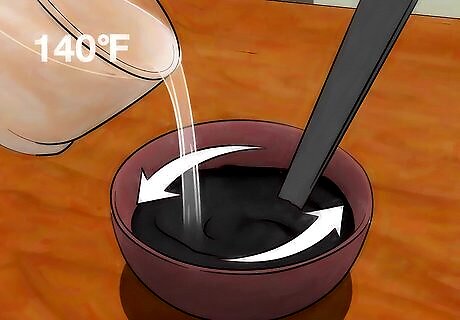
Pre-dissolve your powder dye in a separate container in very hot water. Be sure to dissolve it thoroughly and use a chopstick or any other handy tool you don’t mind staining to stir the mixture until well mixed. If you’re using liquid dye, all you need to do is shake it well before adding it to the bucket. Check the dye packaging to make sure you are using enough dye for the amount of clothing you’re dying. The amount needed varies from product to product, so consult the packaging or insert for exact measurements.

Pour the mixture into your dye bath (the bucket/sink). Make sure that the mixture blends well into the hot water. There needs to be enough water in the bucket so that your garment can move around freely and be stirred while in the dye bath. This is so that your garment will get evenly dyed. Add one tablespoon of laundry detergent to the dye bath. This will help promote dye absorption. Make sure that you stir the laundry detergent into the dye bath until it is well dissolved. When dyeing cotton, rayon, ramie, or linen, add 1 cup of table salt to the dye bath. This will intensify the color. When dyeing nylon, silk and wool, add 1 cup of white vinegar to the dye bath to intensify the color.

Submerge your garment in the dye bath. The longer your garment is left in the dye bath, the darker the result will be. Garments can be left in the bath for up to 1 hour. You will need to constantly agitate and stir the garment while it’s submerged in the bath. Try to keep the temperature of the water as consistently hot as possible. Have a stove top, microwave or tea kettle nearby to heat water up to use to refresh the dye bath. Another option would be to use a large stainless steel pot for the dye bath and go through the process with the pot being heated on the stove to keep a consistent temperature. If you soak your clothing in plain hot water for a few minutes before putting them in the dye bath, it will smooth them out so that they can accept dye even more easily.
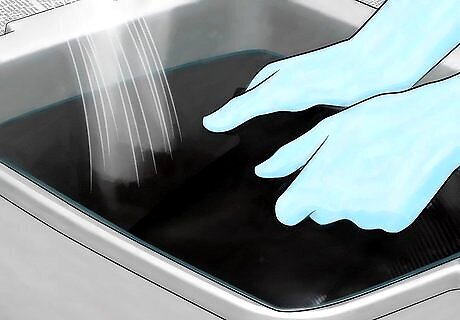
Remove the clothing from the dye bath and rinse it in warm water first. Warm water removes the dye on the surface of the garment more efficiently. After the warm rinse, then rinse in cold water. Keep rinsing until the water runs clear. When you remove the items from the dye bath, they will be wet and appear darker than the final result will be. Turn your items inside out and place them in the washing machine. Wash them alone in warm water with a mild detergent. Use the gentle cycle.
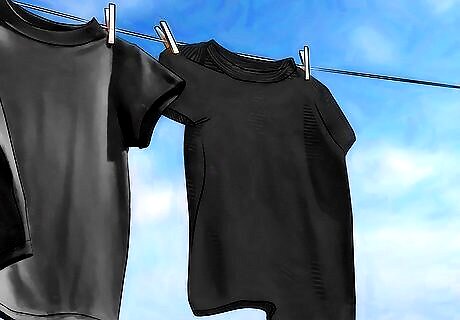
Hang or machine dry the clothing. You can dry your items either way, but hang drying clothing preserves their dark colors, so it’s probably a better idea to get in that habit. Once dry, your clothing is ready to wear. For the first 3 times you wash your newly dyed clothing after wearing, wash the items alone in cold water using the gentle cycle and mild, non-bleach detergent. After that you can wash the dyed items with other items of the same color that haven’t been dyed, but make sure it’s always in cold water and using a mild detergent.
Restoring With Coffee

Put your garments in the washing machine. If you are darkening multiple items, make sure they are all similar in color. Start your normal wash cycle using cold water. This method is most effective when used on cotton fabrics, like faded black t-shirts. The effects aren't as ideal on other types of fabrics. If you want to restore clothing to a very rich black color, coffee is less effective than black fabric dye. Coffee will have more natural-looking results.

Brew up a pot of very strong black coffee. The stronger the coffee, the darker the final outcome will be, so keep that in mind when brewing. You will need 2 cups of coffee for this so use a full sized coffee maker, not a single serve or smaller coffee maker. You can also use 2 cups of black tea instead of the coffee for similar results, if that's your preference. It doesn't matter how you get the two cups of coffee, as long as they are fresh and dark. If you're an instant coffee drinker, it's perfectly fine to make your coffee with that. Being brewed by a coffee maker isn't a requirement.

Add 2 cups of the freshly brewed coffee to the washing machine when the rinse cycle begins. Close the lid of your washing machine and let the machine and coffee do their work. Allow the rest of the cycle to finish up just as it normally would. If you've used commercial fabric dyes on your clothing before, you'll notice that this method smells much better during the process and after. The coffee method is also non-toxic, and you don't have to worry about coffee staining the basin of your washing machine.

Hang your clothing to dry. Machine drying dark garments can lead to fading, so get in the habit of always hanging up your black clothes after washing them to preserve their color. Once dry, the garment is ready to wear.
Preventing Color Loss

Wash dark clothing only when necessary. Each wash cycle contributes to additional fading, so the less you wash them, the better. This is especially true of denim, which fades the most easily. To get away with washing your dark clothes infrequently, take them off and let them air out after wearing them instead of washing. Put the item on a hanger and hang it somewhere by itself for a day before putting it back in the closet. After wearing the item and air drying 2 or 3 times, go ahead and wash it.

Sort your clothes by color and weight before washing them. Always wash your dark colors together, otherwise the colors may bleed and stain any lighter colored items being washed. Also sort your clothing by fabric type and weight. If you wash delicate items with garments made of heavier fabric, the delicates can get damaged and the heavier fabrics probably won’t get as clean as they should. Replace dyeing trips with at-home solutions. "I appreciated the actionable dyeing tips to easily restore faded favorites at home. The prevention section gave helpful clarity, too — hanging clothes to dry instead of machine drying makes a noticeable difference." - Julie R. Find budget-friendly solutions for fading black clothes. "As a cleric on a tight budget, I appreciated learning easy fixes to restore the rich black color of my expensive religious garments without having to buy replacements. The coffee method is especially ingenious — I'm excited to try it out and save money while meeting parishioner expectations." - Joan G. Prevent color loss with simple laundry adjustments. "I used to wash clothes on normal settings, but after reading this, washing them inside out, using less detergent, and switching to gentle cycle helped prevent black clothes from fading. My laundry room got a bit brighter!" - Marry B. Understand the laundry mistakes causing fading. "This article clearly explains little-known reasons for color loss — like water temperature and dryer damage — that we were unintentionally doing wrong for years. Going to overhaul our laundry habits to preserve our dark clothing." - Jason M. Have a story our readers should hear? Share it with 1 billion+ annual wikiHow users. Tell us your story here.
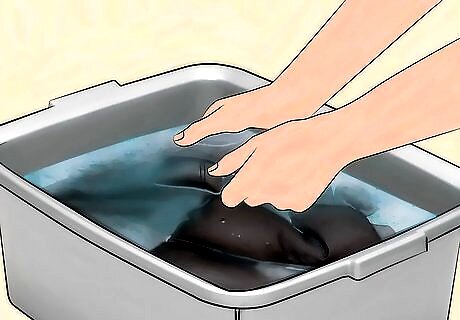
Hand wash your delicate items and fragile fabrics. The agitation caused by your washing machine during a cycle is far too harsh for your delicates. Hand wash these items in cold water to preserve their color and to prevent the items from being damaged. If you really want to avoid hand washing your laundry, the next best thing is to get a small mesh bag for your delicates. Put them in the mesh bag prior to putting them in the washing machine. This will cut down on damage to your delicates. If you have any garments that you are unsure how to launder, dry clean them.
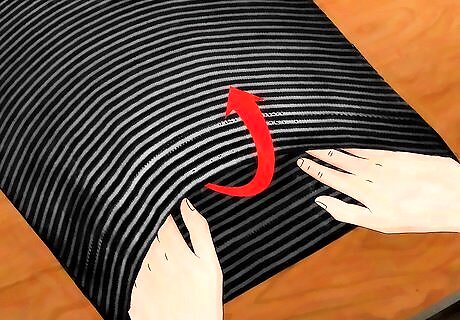
Turn your black clothes inside out before washing them. This protects your black clothing by guarding it against the agitation caused by your washing machine. The wash cycle distresses the fibers of black clothing, which causes them to break down and then fade.
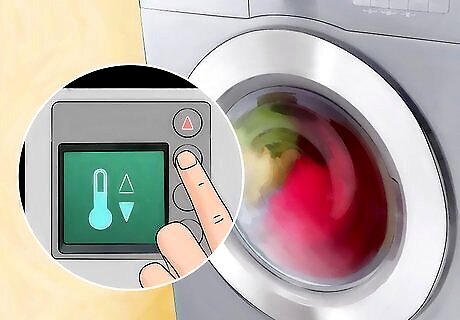
Wash your clothes in cold water using the gentle cycle. Warm and hot water can lead to fading and using any other cycle besides gentle when washing dark colors can also lead to fading. These cycles are much rougher on your clothing and the gentle cycle will protect and preserve garments. If your washing machine also has a soil setting, always use the light-soil setting (unless your clothes are really dirty). The light-soil setting is far gentler on dark color than the other settings.

Use a detergent made specifically for black or brightly colored clothing. Never use regular laundry detergent with bleach or bleach alternatives. Several companies make detergents that are specifically for use with dark colored clothing, so use that if you can find it. Use the minimum amount of detergent necessary to get your garments clean. Excess detergent can lead to fading.

Hang your clothes to dry. Don’t machine dry your black clothes any more, since the dryer can contribute to additional fading. Pull the items from the machine, shake them out and immediately hang the items individually on a rack so that they can dry. Once completely dry, they are ready to be stored in your closet with the rest of your wardrobe.




















Comments
0 comment